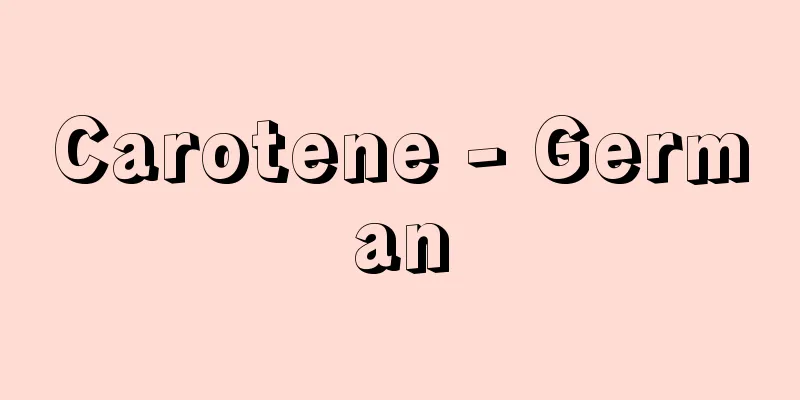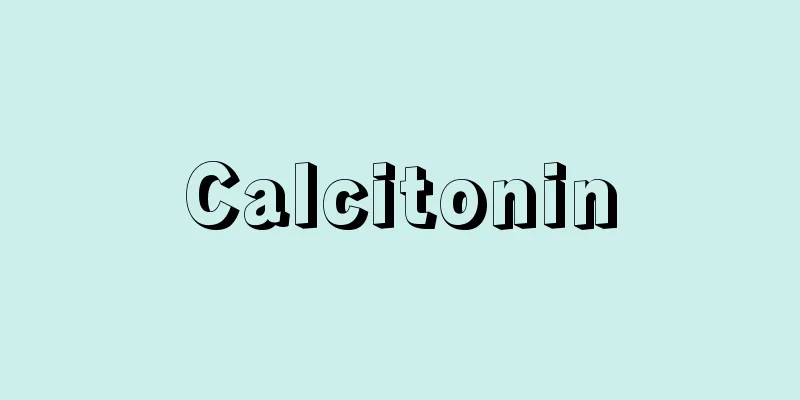Carotene - German

|
Carotenoids that do not contain oxygen in the molecule. Also called carotene. Carotene is a so-called carotenoid hydrocarbon, and there are about 60 types of carotene. The main ones are α (alpha)-carotene, β (beta)-carotene, γ (gamma)-carotene, and lycopene (the red pigment found in tomatoes). α-carotene and γ-carotene exist together with β-carotene, and are present in smaller amounts than β-carotene, so they were initially considered to be one type. The name carotene also referred to a mixture of these. It is a yellow to red pigment that is unstable to oxygen and becomes colorless when oxidized. It is said to have an antioxidant effect and is effective in preventing lifestyle-related diseases. [Michiko Iijima] Provitamin AAlpha-, beta-, and gamma-carotene are provitamin A that are converted to vitamin A in the animal body. Vitamin A (C 20 H 30 O) is a polyene alcohol with two isoprene units. Its molecular structure is characterized by a beta-carotene molecule that is cleaved in the middle and has an alcohol group at the terminal carbon of the side chain. Comparing the vitamin A activity of the three carotenes, beta-carotene is twice as high as alpha- and gamma-carotene. From this, it is thought that provitamin A is oxidized and cleaved in the middle of the molecule in the living body to become vitamin A aldehyde, which is then reduced to vitamin A. It is absorbed through the intestinal wall in the animal body, but the absorption rate is said to be about 30%. [Michiko Iijima] In vivo synthesisVarious studies have suggested that the raw material for synthesis is acetic acid, which is converted via mevalonic acid to produce an isoprene unit with five carbon atoms (C 5 ), which is then converted to C 10 →C 20 →C 40 carbon atoms, followed by isomerization, stepwise dehydration to form an unsaturated chain, and the formation of a benzene ring (C 6 ). α- and β-carotene are always present in green leaves, found together with chlorophyll, and are thought to be involved in photosynthesis. In autumn, when chlorophyll breaks down, the color of carotene, which was previously hidden by the green color, becomes visible. However, the bright red and yellow pigments are not carotene, but polymerized products of anthocyans and tannins. The molecular formula of all four carotenes is C 40 H 56 , and they are isomers of each other. [Michiko Iijima] Alpha-carotenePurple plate-like crystals. Discovered in 1931 by German organic chemist R. Kuhn and his colleagues from carrot carotene (mainly β-carotene). It is widely present in the plant kingdom and is found together with β-carotene, but in small amounts. As an exception, the ratio of α-carotene to β-carotene is reversed in the green algae mill. [Michiko Iijima] Beta-caroteneReddish purple columnar or plate-shaped crystals. The red color of carrots is beta-carotene, which was discovered in carrots in 1831 by German pharmaceutical chemist HWF Wackenroder (1798-1854). It is always present in green leaves, and is also found in fruits, flowers, and roots. Vitamin A can be artificially obtained by oxidizing and reducing beta-carotene. As it is a safe pigment, it is widely used as a coloring agent for cheese, butter, and margarine. Numerous reports have been published since around 1980 about its effectiveness in preventing cancer. Some epidemiological studies since 1990 have shown effectiveness, but many have shown negative results. Therefore, more detailed examination and research are needed. [Michiko Iijima] Gamma-caroteneRed plate-like crystals. Discovered by R. Kuhn and others in 1933. Widely distributed in the plant kingdom, it is found in fruits and petals, but is rarely found in green parts. Although its content is generally low, it exists as the main carotenoid in certain parasitic plants that do not have chlorophyll. [Michiko Iijima] LycopeneRed nail-shaped or purple columnar crystals. The red color of tomatoes is lycopene, which is particularly susceptible to oxidation among carotenes. It was discovered in 1875 by French botanist PMA Millardet (1838-1902), and in 1910 it was revealed to be an isomer of carotene (α-, β-, and γ-carotene). It is found widely in the plant kingdom and in large quantities. It is found in large amounts in fruits and petals, and is rarely found in green parts. Although lycopene is not a provitamin A like the carotenes mentioned above, research on its antioxidant effect focusing on serum lipids, oxidative damage to lymphocytes, and oxidative damage to DNA has shown that its antioxidant activity is no different from that of β-carotene, which has the highest provitamin A activity. [Michiko Iijima] "Retinoids and Carotenoids" by Yasutoshi Muto (1997, Nanzando)" ▽ "Nutritional Epidemiology" by Yoshitaka Tsubono and Shigeru Hisamichi (2001, Nanzando)" ▽ "Vitamin Encyclopedia" edited by the Vitamin Society of Japan (2010, Asakura Shoten)" ▽ "Harper's Biochemistry, 28th edition, by R.K. Murray et al., supervised translation by Yoshihito Ueda and Takao Shimizu (2011, Maruzen)" [References] | | | | | | | | | | | |©Shogakukan "> General structural formula of carotene Source: Shogakukan Encyclopedia Nipponica About Encyclopedia Nipponica Information | Legend |
|
カロチノイドのうち、分子中に酸素を含まないものをいう。カロテンともよぶ。いわゆるカロチノイド炭化水素で、カロチンは約60種存在する。おもなものにα(アルファ)-カロチン、β(ベータ)-カロチン、γ(ガンマ)-カロチン、リコピン(トマトの果実に含まれる赤色の色素)などがある。α-カロチンとγ-カロチンはβ-カロチンと相伴って存在し、量もβ-カロチンに比べて少ないため、最初は1種のものとみなされていた。カロチンという名称も、これらの混合物をさしていた。黄~赤の色素で酸素に対して不安定で、酸化されると無色になる。抗酸化作用を示すことから、生活習慣病の予防効果があるといわれている。 [飯島道子] プロビタミンAα-、β-、γ-の各カロチンは動物体内でビタミンAに変わるプロビタミンAである。ビタミンA(C20H30O)は2個のイソプレン単位をもつポリエンアルコールである。分子構造は、β-カロチン分子が中央で切断され側鎖の末端の炭素にアルコール基を有するという特徴をもつ。3種のカロチンのビタミンA活性を比較すると、β-カロチンはα-およびγ-カロチンの2倍である。このことからプロビタミンAは、生体中では分子の中央で酸化を受けて切断され、ビタミンAアルデヒドとなり、さらに還元されてビタミンAに変わると考えられる。動物体内では腸壁から吸収されるが、吸収率は約30%とされている。 [飯島道子] 生体内での合成さまざまな研究から、合成の原料としては酢酸が考えられており、これがメバロン酸を経て炭素原子5個(C5)のイソプレン単位ができ、さらに炭素原子がC10→C20→C40となり、異性化、段階的脱水反応による不飽和鎖の形成、ベンゼン環(C6)の形成を経てカロチンが生成すると考えられている。α-とβ-カロチンは緑葉中にかならず存在し、クロロフィルとともにみいだされ、光合成に関係していると考えられている。秋、クロロフィルが分解すると、それまで緑色で隠されていたカロチンの色が認められるようになる。しかし、鮮やかな赤や黄色の色素はカロチンでなく、アントシアンおよびタンニンの重合物である。4種のカロチンの分子式はいずれもC40H56で、互いに異性体である。 [飯島道子] α-カロチン紫色板状結晶。1931年ドイツの有機化学者R・クーンらによってニンジンのカロチン(β-カロチンを主とする)から発見された。植物界に広く存在し、β-カロチンとともにみいだされるが、量は少ない。例外として、緑藻類のミルではα-カロチンとβ-カロチンの量比が逆になっている。 [飯島道子] β-カロチン赤紫色柱状ないし板状結晶。ニンジンの赤色はβ-カロチンで、1831年ドイツの薬化学者ワッケンローダーH. W. F. Wackenroder(1798―1854)によりニンジンから発見された。緑葉中にはつねに存在し、果実、花、根にも含まれる。β-カロチンを酸化還元することによって、人工的にビタミンAが得られる。安全な色素なので、チーズ、バター、マーガリンの着色剤として広く使用されている。癌(がん)の予防効果については、1980年ころから多数の報告がある。1990年以降の疫学的調査では有効性を示す結果もあるが、否定的な結果も多い。したがって、より詳細な検討および調査・研究が必要とされている。 [飯島道子] γ-カロチン赤色板状結晶。1933年R・クーンらによって発見された。植物界に広く分布し、果実や花弁に含まれるが、緑色部分にはほとんどみられない。含有量は一般に少ないが、クロロフィルをもたない寄生植物のある種のものでは、おもなカロチノイドとして存在する。 [飯島道子] リコピン赤色釘(くぎ)状ないし紫色柱状結晶。トマトの赤色はリコピンで、カロチンのうちではとくに酸化されやすい。1875年フランスの植物学者ミラルデP. M. A. Millardet(1838―1902)によって発見され、1910年にカロチン(α-・β-・γ-カロチン)の異性体であることが明らかになった。植物界に広く存在し、量も多い。果実や花弁に多く、緑色部分にはほとんどみられない。リコピンは前記カロチンのようなプロビタミンAではないが、血清脂質、リンパ球の酸化障害およびDNAの酸化損傷に着目した抗酸化作用に関する研究から、抗酸化活性はプロビタミンA活性がもっとも高いβ-カロチンと差がないことが示されている。 [飯島道子] 『武藤泰敏著『レチノイド・カロチノイド』(1997・南山堂)』▽『坪野吉孝・久道茂著『栄養疫学』(2001・南江堂)』▽『日本ビタミン学会編『ビタミン総合事典』(2010・朝倉書店)』▽『R・K・マレー他著、上代淑人・清水孝雄監訳『ハーパー生化学』原書28版(2011・丸善)』 [参照項目] | | | | | | | | | | | |©Shogakukan"> カロチンの一般的な構造式 出典 小学館 日本大百科全書(ニッポニカ)日本大百科全書(ニッポニカ)について 情報 | 凡例 |
Recommend
Iwashiro [town] - Iwashiro
A former town in Adachi County in the central east...
Beauty - English
It is difficult to give a definitive definition o...
Sekihoku Main Line - Sekihoku Main Line
The name of the Hokkaido Railway Company's tr...
Global Bearer Certificate (English)
…The first Japanese company to issue ADRs was Son...
Flower purse - Flower purse
A general term for coelenterates (cnidarians) belo...
Norwegian Sea
The sea area between the west coast of Norway and...
Muphahlele
A South African black writer. Born in the slums of...
Kusu [town] - Kusu
A town in Kusu County in western Oita Prefecture. ...
Tom Thumb
An American film produced in 1958. Original title:...
Women's Club - Fujin Club
A women's magazine launched by Kodansha in Oct...
Choi Ik-hyun - Saiekigen
A Confucian scholar from the late Joseon Dynasty,...
Charles Panzéra
French baritone. Born in Geneva. Studied at the P...
Hikosha - Higyosha
[1] One of the buildings in the Heian-kyo Imperial...
Shu Ikki
The leader of the largest peasant revolt during t...
Kamikaze Special Attack Force - Kamikaze Special Attack Force
A special attack force organized by the Imperial J...









